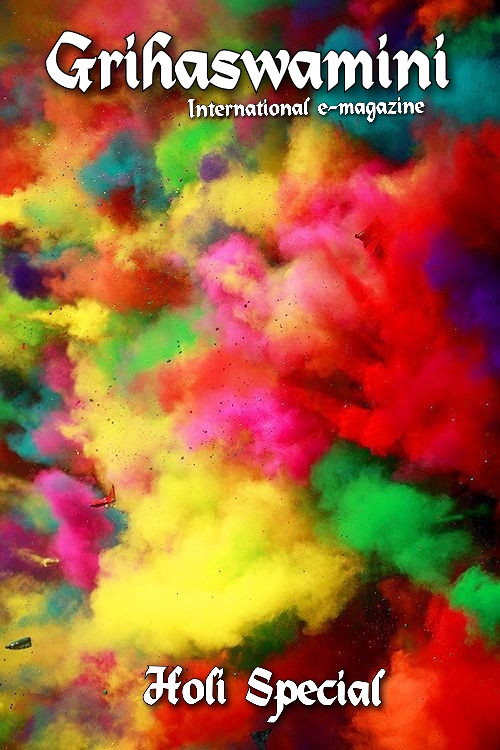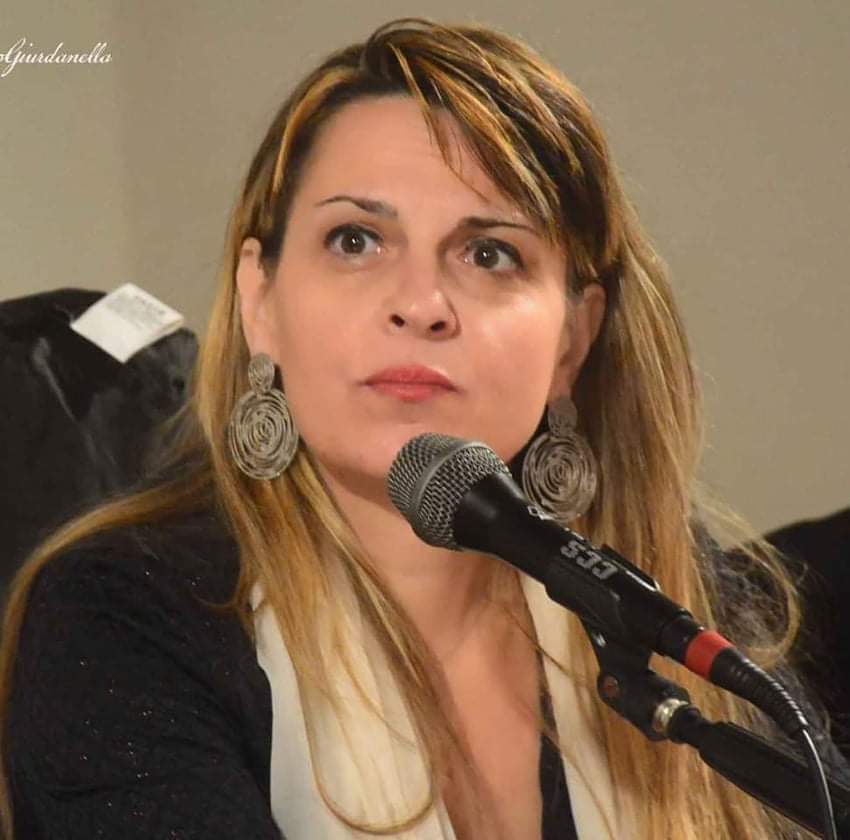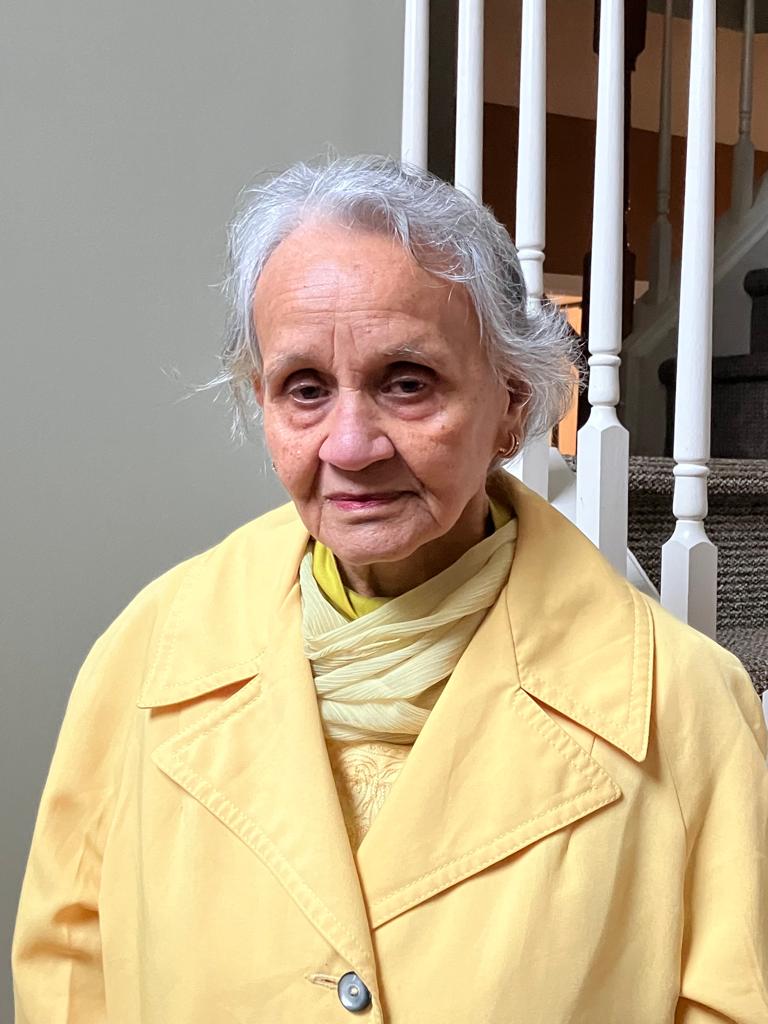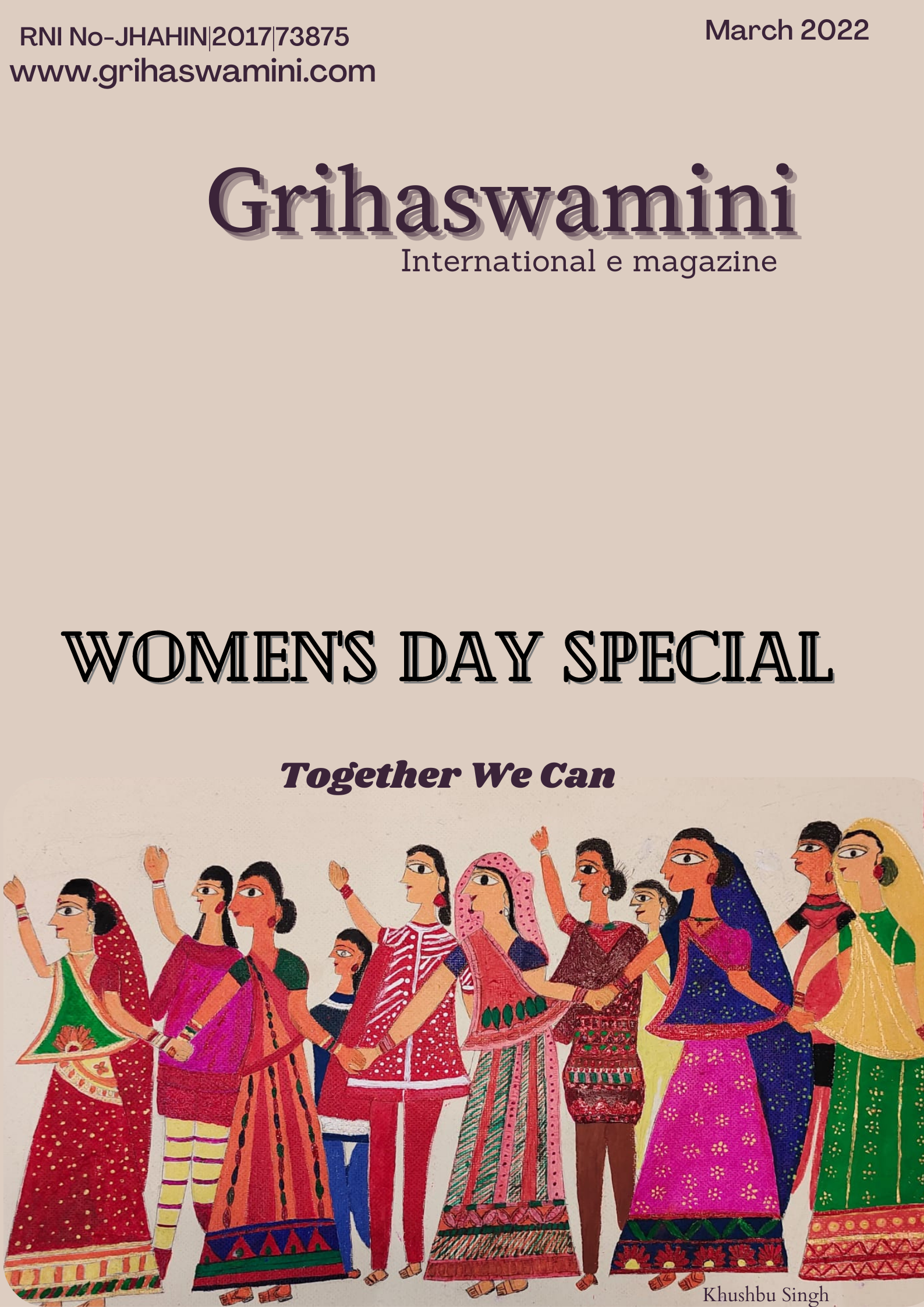The Myriad Colors of Holi- From Brij bhoomi to Imphal in Manipur
The stage is aesthetically decorated and well illuminated. An adolescent Krishna enters stealthily with his friends. All are dressed as cowherds. Krishna has a peacock feather in his hair while ‘gopas’ have shaven heads with a distinctive tuft of hair. From their conversation in Brij bhasha they convey they have come to Barsana village to meet beautiful Radha and her friends. Their village Nandgaon is a short distance away. Krishna is smitten by the ravishingly beautiful Radha and wishes to see her on the day of Holi.

Radha – Krishna playing Holi
(courtesy – internet)
From the other side of the stage a bunch of young ‘girls’, dressed in colourful ‘lehengas’ as gopis enter,chattering and laughing. These too are young boys acting as gopis. In Raas Leela traditionally all characters, whether male or female, are played by boys of appropriate ages. After initial banter the ‘gopis’ try to scare away the ‘gopas’ with sticks. ‘Gopas’ have a shield each to protect themselves. Krishna is watching the fun from a distance. The accompanying music is appropriately boisterous. The ‘fight’ put up by the ‘gopis’ is clearly a half hearted one. The underlying tone being, ‘Oh! We love your presence here but will not admit it openly.’
Meanwhile, Radha enters the stage. Radha and Kirishna look at each other and the atmosphere changes. The director and choreographer of the Raas Leela, Guru Ji, switches over to melodious ragas symbolising divine love. Baskets full of marigold, jasmine and rose petals materialise on the stage. Colourful flowers are showered in abundance, almost drowning Radha and Krishna in a heap. Everyone is dancing and playing holi on the stage. Guru ji is singing ‘Phag’ in raag Kafi. The audience of over a hundred devotees is drenched in divine bliss. By now, Radha – Krishna are walking on the ramp, coming closer to the audience, with others dancing and showering petals on them and on the ecstatic audience.
A memorable experience. I was watching a ‘Raas Leela’ performance – an artistic and sanitized version of the famous ‘lathmar’ Holi played in Brij Bhumi. The real ‘lathmar’ Holi is much more forceful and can even injure. But, the underlying motive is love and not enmity. Through the colourful mist of ‘abir – gulal’ and coloured water, women hit men; the more they fancy a man, the harder is the hit. Rather unusual way of expressing love, but who can argue with traditions and beliefs? People from all over the world come to watch this unique celebration said to have originated thousands of years ago.

Lathmar Holi in Barsana
(Courtesy – Internet)
I was born in Rampur (UP) and brought up in Lucknow. From one week before Holi, one could hear a faint sound of distant ‘dholak’ (Indian drums), riding on the waves of solitude on a spring morning and a lazy afternoon. Holi time, in my growing up years, was associated with vibrant flowers in the garden, balmy breeze and these occasional distant sounds of folk songs.
After marriage, I was amazed to find similar distant sounds of drums in the lush valley of Imphal. More than 2000 km away from Lucknow, tucked in the far north east corner of India, bordering Myanmar, is Manipur. When I got married into the erstwhile ruling family of Manipur, I was pleasantly surprised to find Holi as the most important festival there, with similar colours, similar sounds of folk music but with a distinctive character of its own.
Meities, the local inhabitants of Imphal – capital city of Manipur – start preparations for Holi celebrations well in advance. Phalgun sky is exceptionally clear in Imphal. On the Poornima (full moon) night, as the moon rises highlighting the dark silhouettes of surrounding hills and casting a sparkling reflection in the indigo hued waters of Loktak lake, young boys and girls congregate at a central place in each locality, eagerly looking forward to ‘thabal chongba’ dance. To the rhythmic beat of Manipuri drums (a modified version of a dholak), cymbals and melodious flute these youthful men and women dance hand in hand forming large concentric circles. The dance, accompanying music and folk songs come in waves – fast and slow, rising high and ebbing low. Tonight and for the next four nights every boy is Krishna and every girl Radha. Holi is celebrated for five days in Manipur.

Thabal Chongba Dance
(Courtesy – Internet)
Meities, like many communities elsewhere in India, are traditional and conservative. Young girls are not expected to mingle freely with boys. ‘Thabal Chongba’ used to be the only occasion, especially till a few decades ago, when boys and girls could not only meet but get to hold hands and dance together. Imagine the joy, anticipation and a myriad of emotions in those young hearts. Many promises were made, many relationships formed during these festivities.

Modern version of Thabal Chongba Dance
(Courtesy – Internet)
What connects Brij bhumi in the heart of Uttar Pradesh to distant Imphal? The two are separated by not only a vast stretch of land but also a foregn country in the middle. By air, one flies over Bangladesh; by road there is a narrow corridor through Assam- ‘chicken’s neck’- connecting Manipur to the rest of India. No two places can be more dissimilar to each other than these two. Hot, dry, dusty and arid, Brij is totally flat except for Goverdhan – a small mound called hill. Imphal is surrounded by lush green rolling hills below the lower Himalayas. Set in the middle, like a precious jewel, is the sapphire blue Loktak lake. The hills and the lake change hues as the sun and the moon traverse their course in the sky. No wonder it is called Manipur – the jewel land.
Not only in the landscape, climate and topology, the two places are entirely different from each other in language, food, attire and physical attributes so much so that these could be two different countries. Brij bhasha is a dialect of Hindi while Manipuri falls in the Indo Asian group of languages. Brij has the same food habits as the rest of the Indo Gangetic plains where milk and milk products find a place of pride. Legend says Krishna’s favourite food was freshly churned butter. Many mythologists believe Krishna introduced organised dairy farming some 5-6 thousand years ago in this region.

Baby Krishna stealing butter
(Courtesy – Internet)
Manipuri cuisine, on the other hand, is full of exotic vegetables and lots of fish; all varieties of delicious fish cooked in various ways. Milk and milk products are not used as much. The women of Brij dress in colourful ‘lehengas’ (full length skirts) and bright ‘dupattas’ covering their faces with a veil. The Manipuri women have artistically woven ‘phaneks’ (long ankle length tight skirt) matched with beautiful ‘inifies’ (hand woven very fine sheer stoles) and are fiercely independent economically and culturally. Endowed with Mongolian features Manipuris look more like South Koreans / Japanese than Indians.

Manipuri (Meitei) Meal (Courtesy – Internet)
So, what is common between these two entirely different places and people? What is the common thread? The love and devotion for Krishna is the divine thread that binds and connects these two totally diverse places which are physically separated by thousands of kilometers. There is another big difference. All Manipuris know about this connection but most of the rest of India does not. I, born and brought up in UP, did not know either the depth or the strength of this connection till I went to Manipur as a young bride many decades ago.
Delving into the history of Manipur one finds, more than 300 years ago (1704) the Meities living in and around the valley of Imphal embraced Vaishnavism led by their king Charai Rongba. Since then Vaishnavism became the state religion.
The Manipuri kings were deeply influenced by Chaitainya Mahaprabhu, the 15th century iconic poet saint and his version of ‘bhakti yoga’, where pure devotion becomes the means to attain salvation (moksha) from the bondages of the materialistic world. Holi is also supposed to be the birthday of Chaitanya Mahapraphu, who is believed by Meities to be an incarnation of Krishna.

Chaitanya Mahaprabhu
(Courtesy – Internet)
We all have seen paintings of Chaitanya Mahaprabhu singing devotional songs and dancing in devotion induced ecstasy. He liberated Hinduism from the shackles of ritualistic orthodoxy by giving a simple maha mantra: ‘Hare Krishna….’ to help focus attention on the Divine. The devotion peaks when the devotee, devotion and the Divine all merge into one another (Achintya Bheda Abheda). That is pure bliss, that is liberation which matches with Adi Shankaracharya’s philosophy of non duality (adwaitawad). Chaitainya Mahaprabhu made it so simple for everybody.
Starting from Bengal and traversing through Assam the message of Chaitanya Mahaprabhu took nearly two more centuries, from the 15th century, to reach Manipur. The Meiteis in Imphal valley became Krishna bhaktas and Hindus while the tribals living in the surrounding hills embraced Christianity. This conversion led to differences in their food habits and other traditions. Another one and a half centuries later (in 1846) the original iconic Sri Govinda Ji temple was built during the reign of Maharaj Narsingh in Kangla – the old capitol. My in-laws trace their lineage from Maharaj Narsingh, one of the most famous and effective rulers of Manipur. The present Govinda ji temple endowed with two gold plated domes is located next to the royal palace – an embodiment of the strong thread of Krishna Consciousness that connects Imphal to Brij Bhumi and Manipuris to Brij vasis.

Radha – Krishna Idols in GovindaJi Temple Imphal
(Courtesy Internet)
In the late nineteenth century (1891) Maharaj Kulchandra, the then ruler of Manipur, lost the Anglo- Manipuri war and was exiled by the British to Radha Kund in Vrindavan. A big haveli, euphemistically called ‘chota kila’ (small palace) was built for him. Since then Vrindavan and Radhakund gave refuge to many exiled and fleeing Manipuri nobility.
This trickle became a stream during the Second World War. Imphal was heavily bombed at that time. Many Meities relocated themselves to Radha Kund. Besides, Manipuri widows, like their Bengali counterparts, sought refuge at the lotus feet of Krishna and settled down in these areas. They could have gone elsewhere but their devotion to Krishna must have made the choice a bit easier.
The royal family of Manipur constructed a ‘Dharamshala’ in Vrindavan and a temple in Radhakund. There is a thriving Manipuri (primarily Meitei) colony. Every Manipuri’s wish is to have his / her last rites performed in Radha kund. I was surprised to find the local priests, who are from UP, speaking flawless Manipuri – an absolutely amazing sight. My father in-law’s eldest brother also lived in Radha Kund for a long time. He even got a temple constructed there. A particular family of local priests has been looking after this temple for generations. The current priest, who is a typical ‘Mathura ka Panda’ (Pandas are priests from Mathura) performed all the ceremonies in chaste Manipuri, when my mother in law passed away a few years ago and we went to Radha kund with her ashes.
Krishna consciousness is so deeply steeped in Manipuri Meitei culture that it resonates in their dance, marriage ceremonies and almost every ritual along with their original Sanamahi religion; a beautiful blend indeed.

Radha – Krishna Raas Leela
(Courtesy – Internet)
Humans, by nature, are inclusive. The Meiteis, after becoming vaishnavites, interestingly and effortlessly amalgamated their centuries old native festival of Yaoshang with Holi. For children this is the most enjoyable part of the festival. They make a thatched hut of twigs, hay and sticks. They ‘steal’ vegetables and other eatables from their homes. The elders become partners in ‘crime’ by making these items easily accessible to the young ones. Children cook a meal, have fun and spend a night in the hut. Next day it is set ablaze very much like the ‘holika dahan’ in the rest of the country. The day after everyone plays with colours.
Another major attraction, especially when monarchy was still there, was processions from various localities coming to pay obeisance to the King and receive blessings from him. Each locality had its unique colour. All the members from that locality would be dressed in that same colour. Dancing and singing, with ‘abir’ on their faces, to the beat of Manipuri drums, all groups in myriad colours would congregate at the palace and then go to the Govinda ji temple. Unfortunately some of these beautiful customs are getting extinct with time. Nowadays, many sports competitions are organised during these five days of fun and festivities in Imphal.
Holi has so many varied colors, played in so many different forms throughout our vast country. The form changes from the north to the south and from the east to the west. Despite superficial changes in the form, the substance remains the same; rise above the petty squabbles of everyday life and embrace all in universal peace and brotherhood.
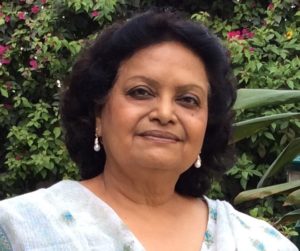
Neerja Rajkumar
IAS (Retd)
Retired as Chief Secretary of Karnataka
Gurgaon, Haryana

